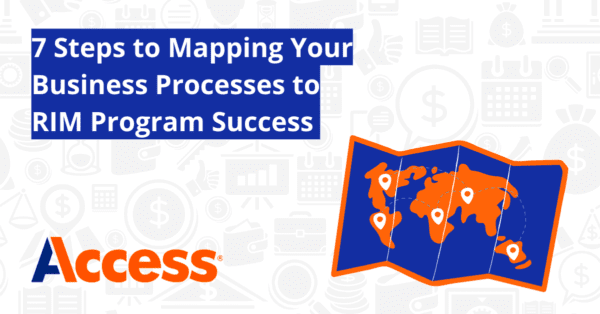
We’ve talked before on this blog about what tackling a larger digitization process looks like. However, your success in following these plans hinges on how effective you map out your start. That is, do you understand the business process you’re trying to digitize?
This week we’re going to give a brief overview of how to map business processes and how that can make digitizing a paper process easier to manage.
What is a Business Process?
Gartner defines a business process as “an event-driven, end-to-end processing path that starts with a customer request and ends with a result for the customer”. In the case of an information management lens, the customer may be internal, external, or both, but our focus is on what happens to the information at every step of the process.
It’s easier to understand with a concrete example, so to illustrate this, we’ll use the application process for a loan from a credit union.
The process starts when a customer kicks off the process and ends when the records created by this process are no longer needed. Throughout this process, various pieces of information are needed from the customer (credit score, pay stubs, etc.) and these must be passed to the correct groups or applications to review.
These must then be securely managed in systems that are accessible only to the people or applications that need to access them. At some point in the process, the customer will learn whether they have been approved or denied for the loan, but the process isn’t complete as far as information management professionals are concerned.
Depending on the jurisdiction, the credit union will have to retain the records of this application for a certain period of time and then dispose of them once they’ve passed their retention date.
Why Should RIM Programs Map their Business Processes?
So why then, is it important to map out a process like the one above?
For one thing, it helps us understand who needs to be involved and where. By having a recorded, mapped process, it’s easier to standardize it. According to a 2021 ARMA survey, processes continue to be a struggle for information management programs as nearly half reported they were deficient in this area.
Second, having an in-depth understanding of how this business process and information flows through the organization makes it easier to improve upon. If you don’t understand where the bottlenecks are in the first place, it’s impossible to remove them.
Finally, we used a simple, streamlined process as an example here with one person’s information going into the system with a yes or no outcome. Consider instead a healthcare system where there are an untold number of variables and people, processes, and applications that might be involved in order to provide care.
The more moving parts there are, the more complex information management and governance becomes. Mapping out your business processes in this way is important for your information management program and the organization as a whole as it shows how information flows throughout the lifecycle from capture to disposition.

Beyond Storage – A Comprehensive Information Management Checklist
Organizations of all kinds and sizes are finding themselves faced with an array of information management challenges. Some of these challenges, like the transformation of information technologies and the growth of data sets, have remained relatively unchanged for years.
Steps for Getting Started When Reworking a Paper-Based Process
1. Choose a Format for Mapping Your Process
Some common ways to map a process include flowchart language like Business Process Modeling Notation (BPMN), a swim lane diagram, or even a standard flowchart. What’s important is that you have a visual, common language that everyone in the organization will be able to understand and digest.
2. Identify a Process that Needs to be Mapped
It’s important to start with something small. Trying to do everything at once is a surefire path to trouble. For instance, if you identify that the most paper-based department in your organization is Accounts Payable, don’t try to digitize the whole thing at once. Instead, focus on a small achievable goal like how incoming paper invoices are handled and scale from there.
3. Get the Right Stakeholders Together
Understanding who the correct stakeholders are for a given process is vital. You want to be sure that the people involved in mapping a process are those who are closely involved in the current day-to-day workflow so they understand the pros and cons of various new options. Likewise, you need to be able to identify who, in the end, is responsible for the process – giving you a clear decision-maker if and when the need arises.
4. Produce and Document Your Baseline Map
Based on the feedback involved, create your process map based on the chosen format.
5. Get Feedback
Share the initial map with your stakeholder group and ask for feedback. You’ll want to ensure there’s nothing missing from the process and that you’ve properly covered each step so you can communicate each stakeholder’s involvement and/or benefit in the process.
6. Identify Areas for Improvement
Are there areas of this process that can be automated, streamlined or otherwise eliminated? Due to the rapid digitization shift in work over the last two years, people are already gravitating toward more nimble ways of working so there may not be a need for the paper in a particular process at all.
7. Implement, Monitor, and Repeat
It’s now time to do most of the work outlined in “How to Transition from Paper-Intensive to Digital-First”. After implementation, there should be a period of monitoring to make sure the new process is working smoothly and so any hiccups can be fixed as they arise. Then it’s time to implement or tweak the process over again to achieve the next goal in the organization.
Conclusion
The ability to understand and then improve upon a business process can have positive effects you may not even realize.
For instance, reducing the amount of labor, administration, or time spent simply looking for documents can allow your organization to be more focused on doing the work that matters for significantly higher productivity.
For a more holistic overview on digitizing, check out our two-part series “How to Transition from Paper-Intensive to Digital-First” (part 1 and part 2), or download our eBook, Accelerating Digitization to Meet Today’s Remote Work Requirements.




